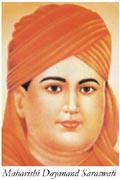Growth of the Arya Samaj
From the 1880s, the Arya Samaj founded new associations and organizations to enlarge its constituency among the Jats and helped them strengthen their identity as a devout and self-contolled warrior caste, and not merely as a sturdy country folk.

Swami Dayanand toured southeast Punjab in 1879 for the first time when he went to Ambala and Rewari. Among the earlier followers in the region were Lala Lajpat Rai, Pandit Lakhpal Rai, Lala Chura Mani and Chandu Lal, who set up a branch of the Arya Samaj in Hissar in 1889 and built a temple there in 1893. During the 1880s, they intensified their activities among the Jats especially in Hissar, where Lala Lajpat Rai practiced law.
In the 1880s, a branch of the Arya Samaj was established in Rohtak by Rai Sahib Sansar Chand, who succeeded in drawing the villages of Sanghi and Kiloi in Rohtak into the Arya Samaj fold.
The cultural links with Rajasthan and the migration of the Jats from the Bikaner region also contributed to the dissemination of the Arya Samaj in the Hissar-Rohtak tracts in the 1890s. Swami Dayanand had visited Rajasthan in the 1870s. His nine day long stay in Bharatpur is said to have bolstered the Arya Samaj cause in the region.
The emergence of the Arya Samaj had many visible effects in the region. It was common for converts to read the Satyarth Prakash, observe Sandhya, participate in Havan and Updesh, sing bhajans and develop an interest in cow protection. Chajju Ram established gau-shalas in Bhiwani and Calcutta. Nawal Singh of Rohtak opened one in Haridwar. As a result of these initiatives, a way was paved for an effective gau-raksha (cow protection) movement in southeast Punjab.
The endorsement of karewa (widow re-marriage) by the Arya Samaj enabled educated Jats to observe it and encouraged widow re-marriage.
Impact of Arya Samaj
The Jats viewed the Arya Samaj in a variety of ways towards the end of the 19th century. They gave up their initial reservations and adapted themselves to a new mode of collective life. Doubtless, there were some feeble protests against the emerging hegemony of the Arya Samaj, but these voices gradually died down.
The Arya Samaj inspired the Jats via existing beliefs and cultures. This, in a large part, accounts for its success as an ideology and a movement.
The diffusion of the Arya Samaj precepts and associated quami narratives had far reaching consequences beyond its direct impact on the community. First, the emerging Jat identity created tension with the Muslims. The prevalent syncretic culture came to an end. Secondly, it alienated colonial officials. The result was a new colonial stereotype which represented the Jats as violent and clannish by nature.
By the early twentieth century, the Jats entered public life as political actors, moral pundits, school teachers, lawyers, popular scholars and peasant sepoys. With this grew the notion of a homogeneous Jat community. The Arya Samaj played a vital role in the cultural and political mobilization of the Jats and their emergence as an assertive community.
Arya Samaj movement also paved the way for upliftment of women through educational opportunities, removal of social evils like smoking, drinking, sati tradition, purdah system etc. It also made the village life easy because of removal of superstitious practices like offering meals to Brahmins on full-moon nights and on marriages, birth and even death.
.
See also
Back to History

